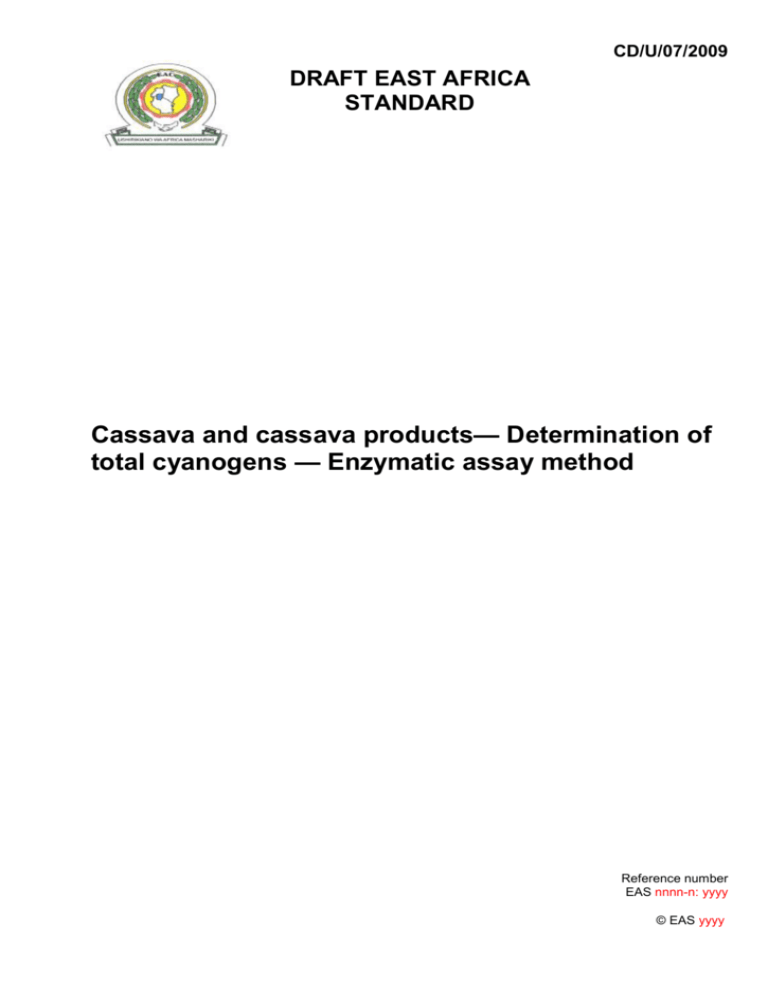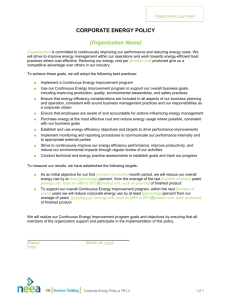
CD/U/07/2009
DRAFT EAST AFRICA
STANDARD
Cassava and cassava products— Determination of
total cyanogens — Enzymatic assay method
Reference number
EAS nnnn-n: yyyy
© EAS yyyy
EAS nnnn-n: yyyy
Compliance with this standard does not, of itself confer immunity from legal obligations
The East African Standard does not purport to include all necessary provisions of a contract. Users
are responsible for its correct application
© EAS yyyy
All rights reserved. Unless otherwise specified, no part of this publication may be reproduced or utilised in any
form or by any means, electronic or mechanical, including photocopying and microfilm, without prior written
permission from UNBS.
Requests for permission to reproduce this document should be addressed to
The Executive Director
Uganda National Bureau of Standards
P.O. Box 6329
Kampala
Uganda
Tel: 256 41 505 995
Fax: 256 41 286 123
E-mail: unbs@infocom.co.ug
ii
© EAS yyyy – All rights reserved
EAS nnnn-n: yyyy
Contents
Page
Acknowledgements ............................................................................................................................................ v
1
Scope ..........................................................................................................Error! Bookmark not defined.
2
Normative references ............................................................................................................................ 1
3
Principle ................................................................................................................................................. 1
4
Reagents ................................................................................................................................................ 1
5
Apparatus ............................................................................................................................................... 2
6
Procedure ............................................................................................................................................... 2
6
Test report .............................................................................................................................................. 3
© EAS yyyy – All rights reserved
iii
EAS nnnn-n: yyyy
Foreword
Development of the East African Standards has been necessitated by the need for harmonizing requirements governing
quality of products and services in East Africa. It is envisaged that through harmonized standardization, trade barriers
which are encountered when goods and services are exchanged within the Community will be removed.
In order to achieve this objective, the Partner States in the Community through their National Bureaux of
Standards, have established an East African Standards Committee.
The Committee is composed of representatives of the National Standards Bodies in Partner States, together
with the representatives from the private sectors and consumer organizations. Draft East African Standards
are circulated to stakeholders through the National Standards Bodies in the Partner States. The comments
received are discussed and incorporated before finalization of standards, in accordance with the procedures
of the Community.
East African Standards are subject to review, to keep pace with technological advances. Users of the East
African Standards are therefore expected to ensure that they always have the latest versions of the standards
they are implementing.
© East African Community 2000 — All rights reserved*
East African Community
P O Box 1096
Arusha
Tanzania
Tel: 255 27 2504253/8
Fax: 255-27-2504481/2504255
E-Mail: eac@eachq.org
Web: www.each.org
* 2000 EAC — All rights of exploitation in any form and by any means reserved worldwide for EAC Partner States’ NSBs.
iv
© EAS yyyy – All rights reserved
EAS nnnn-n: yyyy
Acknowledgements
This standard and other standards for cassava and cassava products were developed with support from the
Association for Strengthening Agricultural Research in Eastern and Central Africa – Eastern and Central
Africa Programme for Agricultural Policy Analysis (ASARECA-ECAPAPA) project. The project helped in the
mobilisation of stakeholders and covered some of the costs involved in the process of formulation of the
standards. This support and the support from all other stakeholders is hereby acknowledged.
© EAS yyyy – All rights reserved
v
EAS nnnn-n: yyyy
Introduction
Cassava (Manihot esculenta Crantz) is one of the staple food crops. A major drawback of cassava utilization
is its potential toxicity due to the presence of endogenous cyanogenic glucosides.
Processing of cassava should reduce the cyanogenic glucosides to an acceptable level. This test method
therefore, is intended to be used for determination of the cyanogen content in cassava and its different
products as a measure to safeguard the health of the consumers.
vi
© EAS yyyy – All rights reserved
EAS nnnn-n: yyyy
Cassava and cassava products — Determination of total
cyanogens — Enzymatic assay method
1
Scope
This Regional Standard specifies a method for the determination of total cyanogens in cassava and cassava
products.
2
Normative references
No normative references have been foreseen for this method.
3
Principle
Linamerase hydrolysis cyanogenic glucoside compounds of cassava extract in orthophosphoric acid medium
to produce cyanohydrins which rapidly decompose to cyanide ion in alkali (NaOH), followed by addition of
excess pH 6 buffer and chloramine-T to produce a purple solution which is measured spectrophotometrically
4
Reagents
4.1
NOTE
Linamarin, stock solution (5 mmol) made by dissolving 31.0 mg of Linamarin in 25 mL buffer, pH 6
Weighing should be done quickly as the compound is hygroscopic.
4.2 Linamarase, stock solution made by dissolving linamerase enzyme in a 0.1 M sodium phosphate buffer
to obtain a 2.5 µg linamarin in 0.1 M aliquot
4.3
Isonicotic acid
4.4
1, 3-dimethyl barbituric acid
4.5 Acetone cyanohydrin (99 %), stock (5 mmol) made by first dissolving 570 L (0.532 g) in 25mL of 0.1
M orthophosphoric acid, and from this solution, making 1.00 mL up to 50 mL with 0.1 M orthophosphoric acid.
Because of the poor performance of the pure compound in a pipette, the added quantity should also be
weighed for accurate calculation of concentration. The refrigerated stocks can be stored for several weeks to
months.
4.6 Potassium cyanide (KCN), stock (5 mmol) made by dissolving 163 mg dry and pure KCN in 500 mL
0.2 M NaOH. KCN should be dried for at least 12 h over concentrated H2SO4.
ICS nn.nnn.nn
Price based on nn pages
© EAS yyyy– All rights reserved
EAS nnnn-n: yyyy
Standard solutions of 80 mol and 320 mol are made from the stock solutions by making 1.60 mL of them up
to, respectively 100 mL and 25 mL with 0.1 M orthophosphoric acid. This results in 8 nmol/tube and 32
nmol/tube and absorbance of about 0.220 absorbance unit (AU) and 0.880 AU depending on the
spectrophotometer. KCN standards are made just prior to analysis and applied as 0.1 mL to 0.5 mL
orthophosphoric acid and 3.4 mL buffer, pH 6 or as 0.1 mL to 3.9 mL buffer, pH 4.
4.7
Chloramine T solution.
4.8 Colour reagent, pure NaOH (3.7 g) is dissolved in 200 mL distilled water. 7 g of 1,3 - dimethyl
barbituric acid and 5.7 g isonicotinic acid are dissolved in this alkaline solution by extensive stirring. The pH is
adjusted between 7 and 8 with 1M HCI or NaOH. This reagent can be kept for at least 12 days at room
temperature.
NOTE
5
Stock solutions and reagents should be of analytical grade.
Apparatus
Ordinary laboratory apparatus, and a spectrophotometer
6
Procedure
6.1
Sample preparation
Cut fresh cassava root or moist products into 1 cm cubes and randomly take 50 g cassava cubes and
homogenize in 250 mL refrigerated 0.1M orthophosphoric acid in a blender for 15 s at low speed, followed by
60 s at high speed, 60 s of rest and 60 s at full speed again.
For flour 4 g is swirled gently in 25 mL of refrigerated extraction medium in a 50 mL closed container for 5 min.
Extracts are best analysed immediately, but if not, they should be stored refrigerated or frozen for up to two
months.
6.2
6.2.1
Analytical assay
Cyanogenic potential.
0.1 mL extract is added to 0.4 mL buffer, pH 7, in a test tube, followed by addition of 0.1 mL linamarase
solution. After 15 min incubation at 30 °C, 0.6 mL NaOH (0.2 M) is added, followed after 5 min, by 2.8 mL
buffer, pH 6.Coloration is as described in 6.3.
6.2.2
Non glucosidic cyanogens
0.1 mL extract is added to 0.6 mL of NaOH (0.2 M) .After 2 min, 3.3 mL buffer, pH 6 is added, followed by
coloration (6.3).
6.2.3
Free cyanide (HCN)
0.6 mL extract is diluted with 3.4 mL buffer, pH 6 and assayed by colorimetry (6.3).
NOTE
Cyanogens are assayed in duplicate and all assays are carried out in glass -stoppered test tubes. The
contents of the tubes are mixed after each addition.
ii
© EAS yyyy – All rights reserved
EAS nnnn-n: yyyy
6.3
Colorimetric procedure
0.1 mL Chloramine -T reagent (2 % w/v) is added to the 4 mL buffered extract in the test tubes and mixed.
After 5 min, 0.6 mL of color reagent is added and mixed. The absorbance at 605 nm is measured after 10 min.
Reagent blanks are run for each analysis. In a digital single beam spectrophotometer, the absorbance can be
measured between 0.050 AU and 2.000 AU (Absorbance Unit). In less sophisticated analog equipment,
absorbance can be measured between 0.100 AU and 1.200 AU with acceptable accuracy.
6.4
Calculation of cyanogen content
Cyanogen levels are calculated in mg HCN equivalent per kilogram sample on dry weight basis (mg HCN
equivalent kg -1, DWB) as follows:
0.027 v
HCN equivalent ═
ds 1
sm
100
100
m
where,
s
is the sample weight in grams (g);
v
is the volume, in millilitres, of the extraction medium;
d
is the volume, in millilitres, of extract assayed; and
m
is the moisture content, %.
Dry 5 g to 10 g sample (to constant weight), at 105 °C ± 2 °C (oven) or 70 °C in a vacuum oven and calculate
the moisture content (%).
is the quantity of cyanogens (nmol) in the tube, calculated from calibration curve as follows:
A605 w
Slope
where,
A605 is the absorbance measured at 605 nm. Both slope and intercept "w" are derived by linear regression
of the calibration points by means of a calculator. For very low values of "w" (<0.005) and higher
values of A605 (>0.200) the intercept can be neglected.
6
Test report
The test report shall show the method used and the result obtained.
lt shall also mention any operating conditions not specified in this standard, or regarded as optional, as well as
any circumstances that may have influenced the result.
The report shall include all details required for the complete identification of the sample analysed.
© EAS yyyy – All rights reserved
iii
EAS nnnn-n: yyyy
iv
© EAS yyyy – All rights reserved
EAS nnnn-n: yyyy
Bibliography
[1] Cooke, R.D., 1978, Enzymatic Assay for Total Cyanide Content of Cassava (Manihot esculenta
Crantz).Journal of the Science of Food and Agriculture, 29(4):345-352.
[2] Essers, AJ.A, Bosveld M., Van der Grift R.M and Voragen AG.J 1993.Studies on the Quantification of
Specific Cyanogens in Cassava Products and Introduction of a New Chromogen. Journal of the Science
of Food and Agriculture, 63(3):287-296.
[3] O'Brien G.M Taylor, A.J. and Poulter, N.H. 1991. lmproved Enzymatic Assay for Cyanogens in fresh and
Processed Cassava. Journal of the Science of Food and Agriculture, 56(3):277:2
© EAS yyyy – All rights reserved
v






